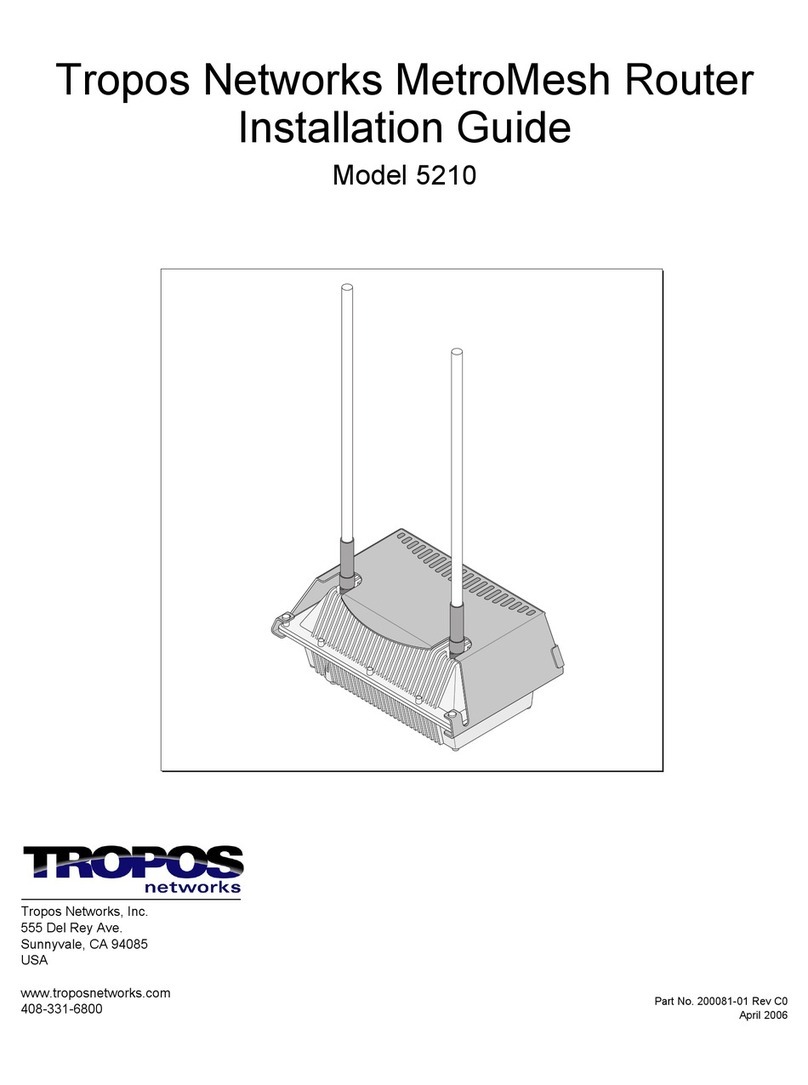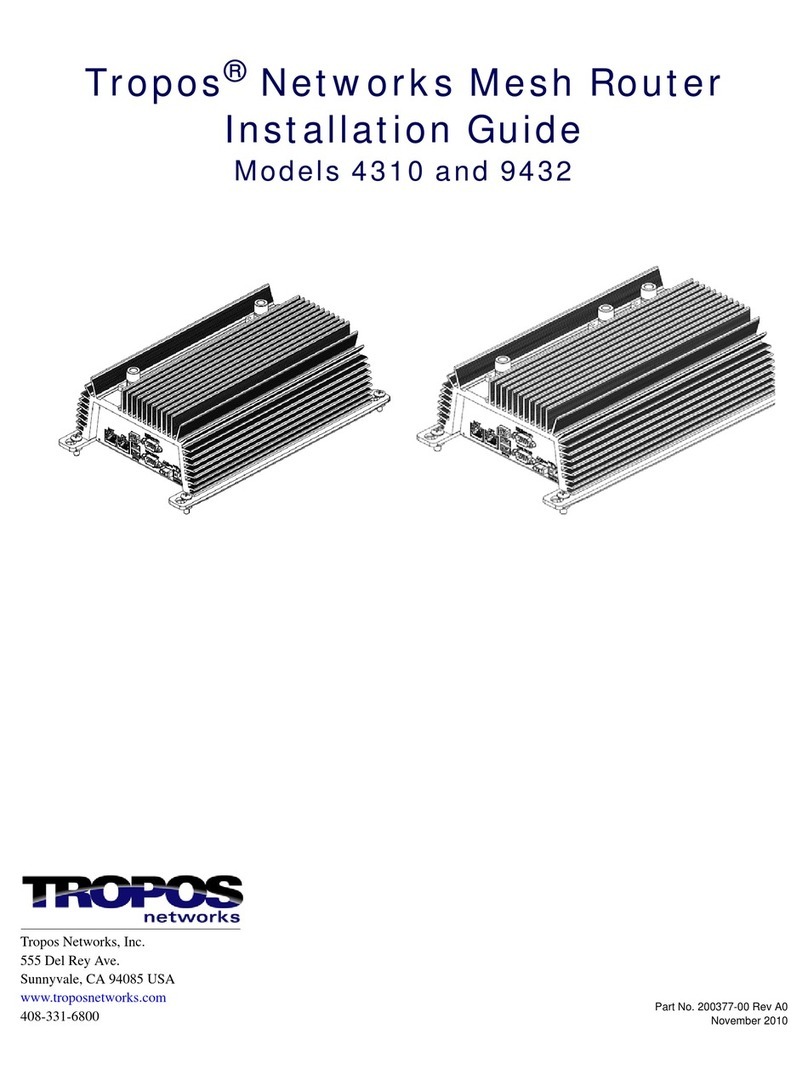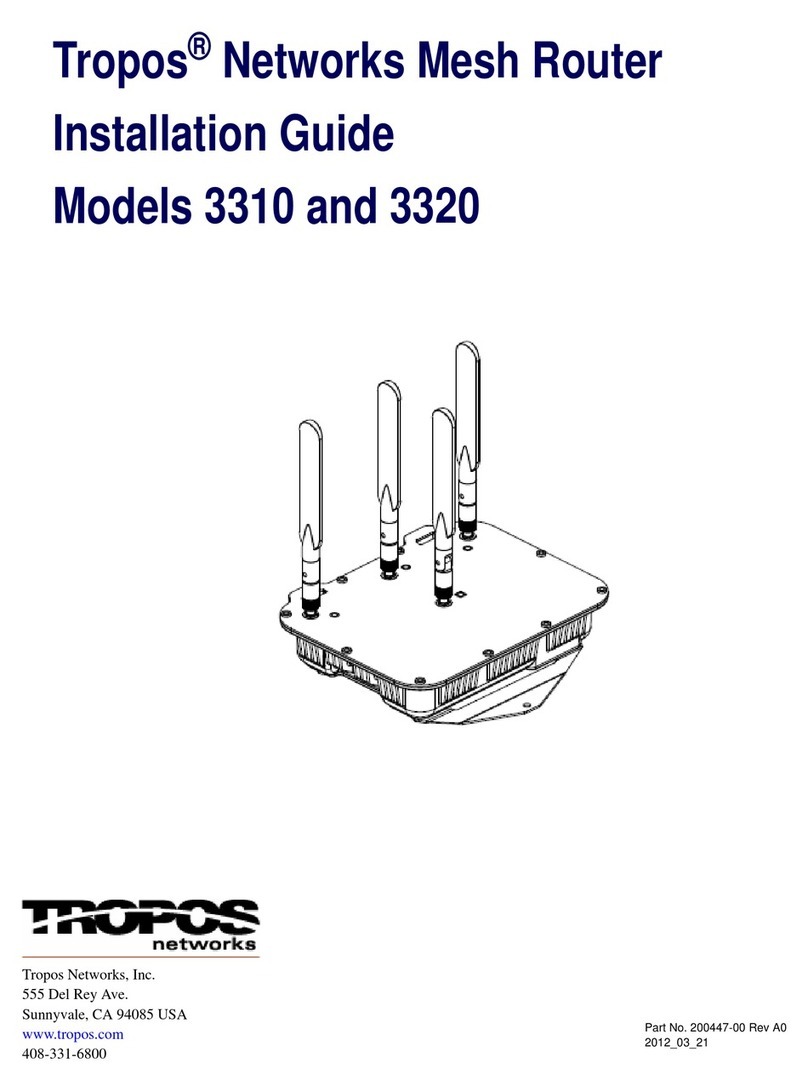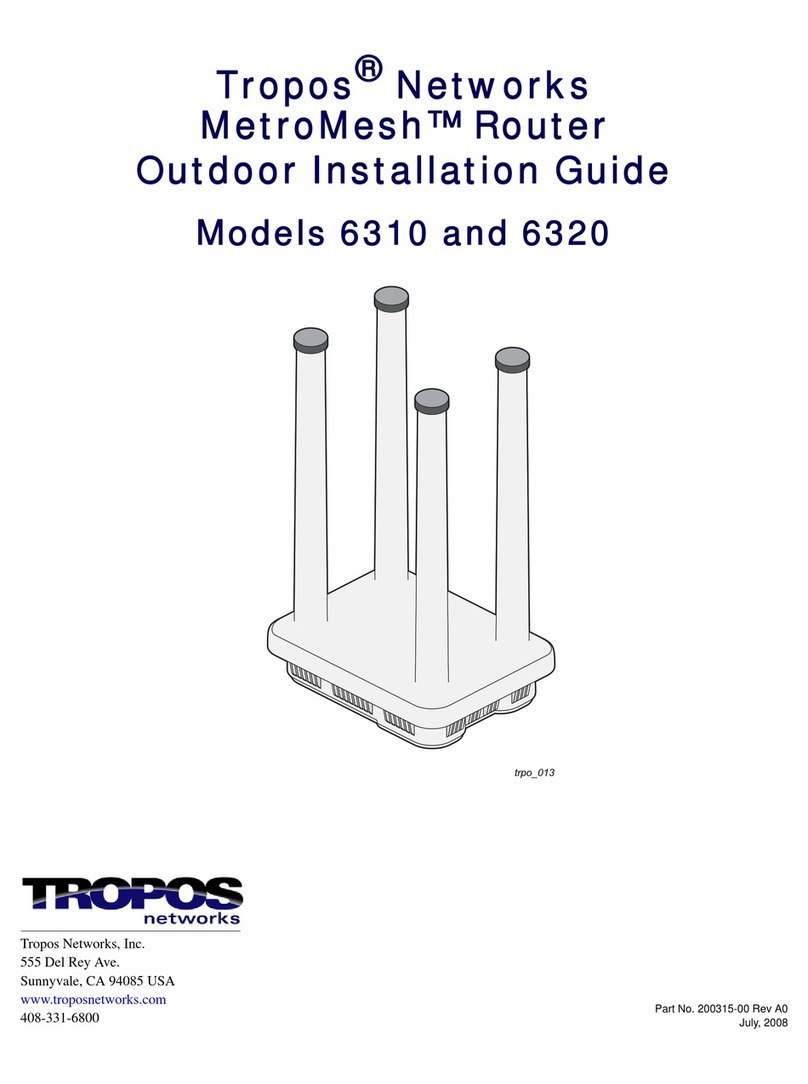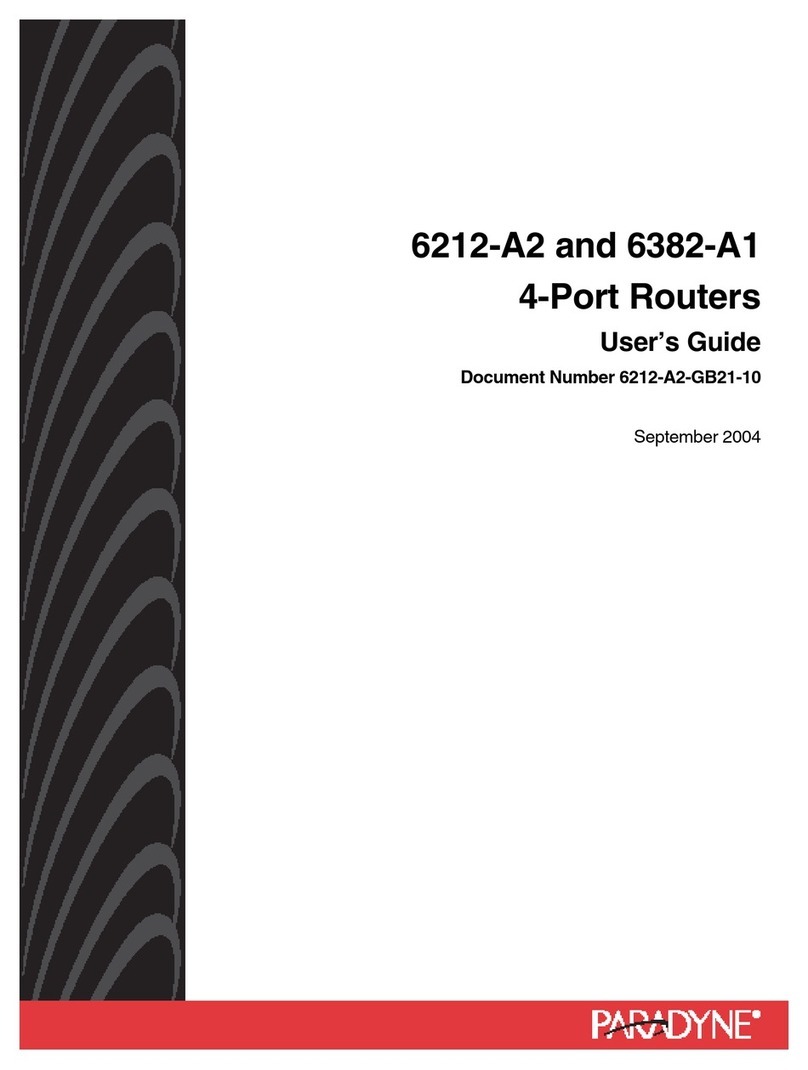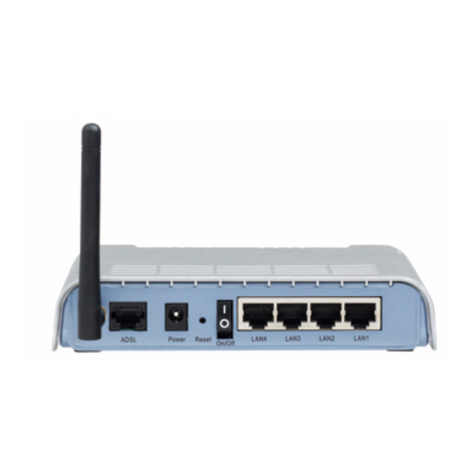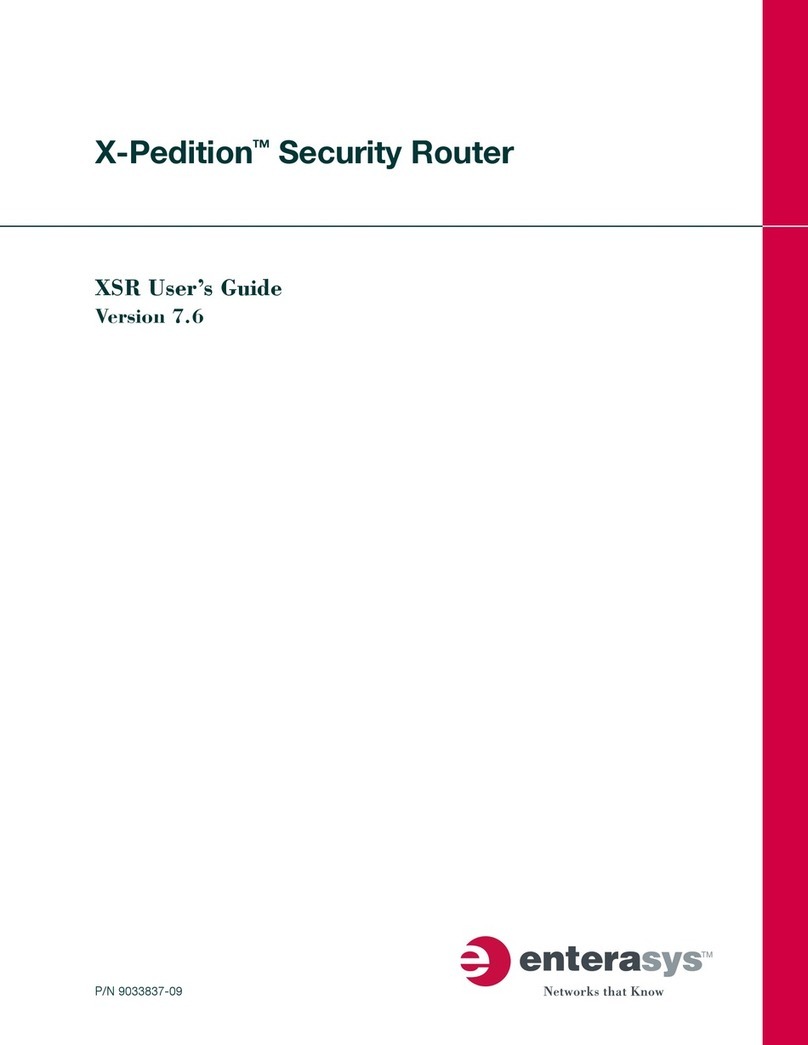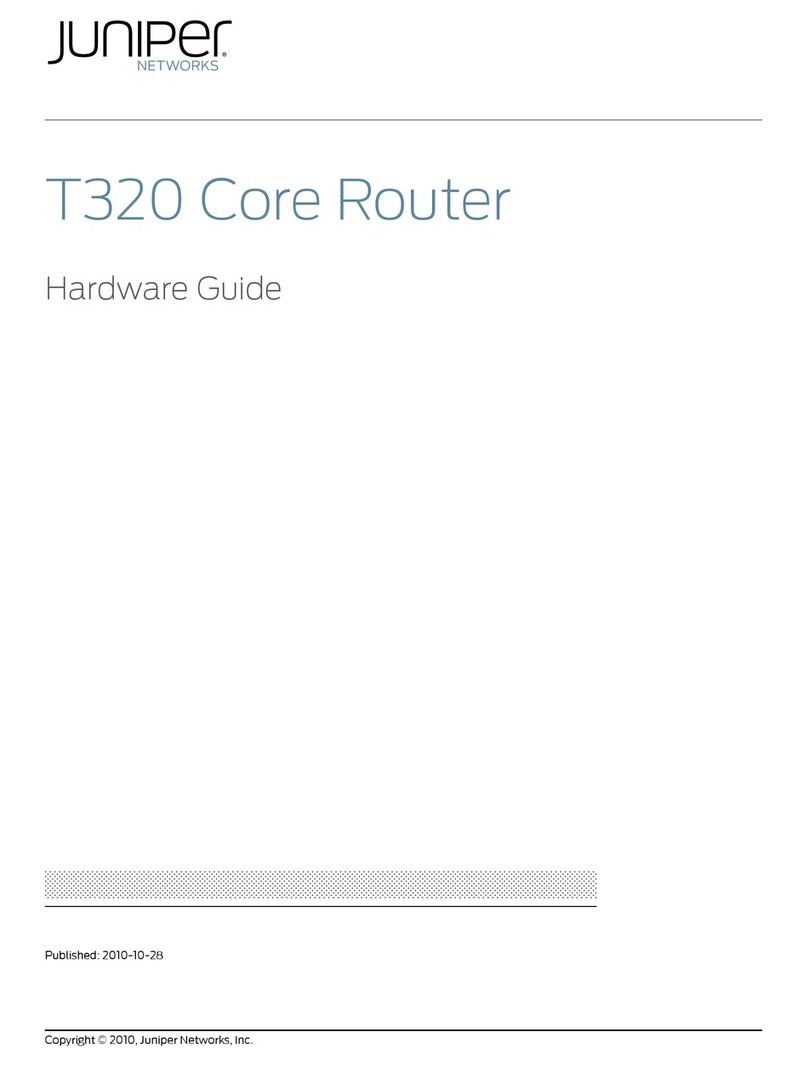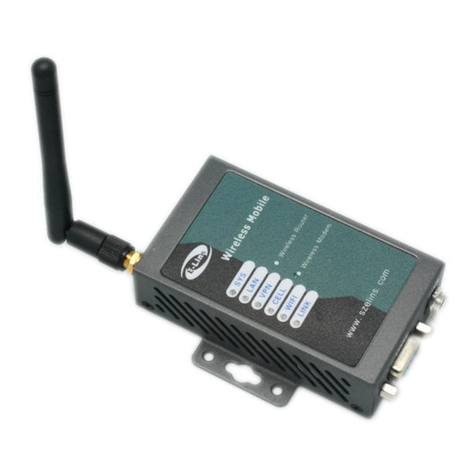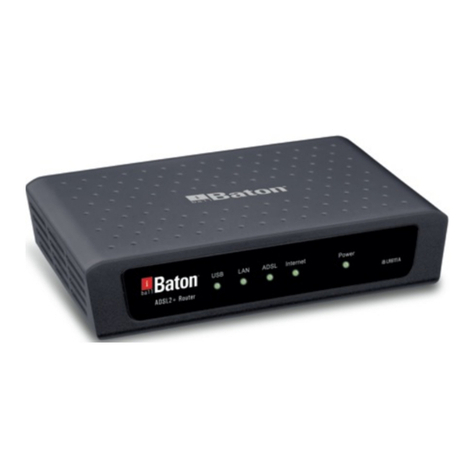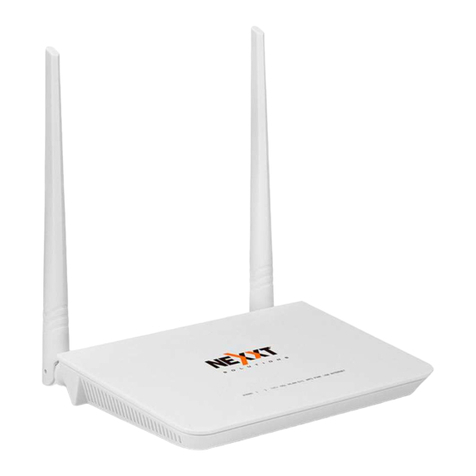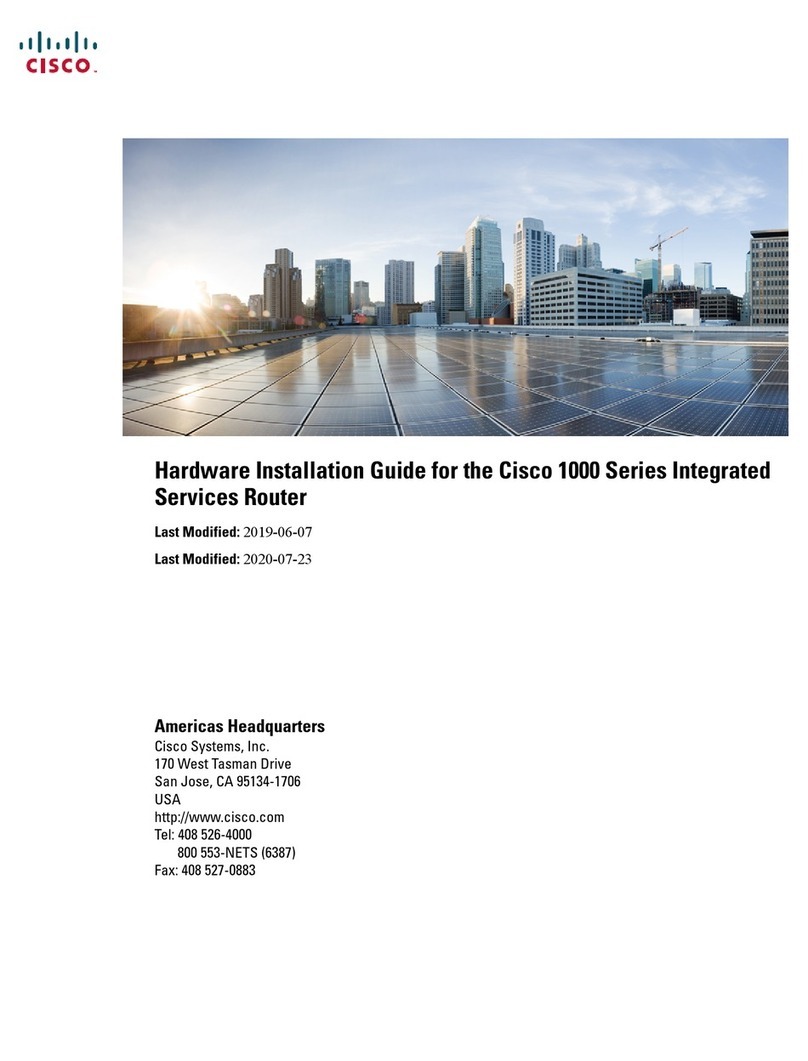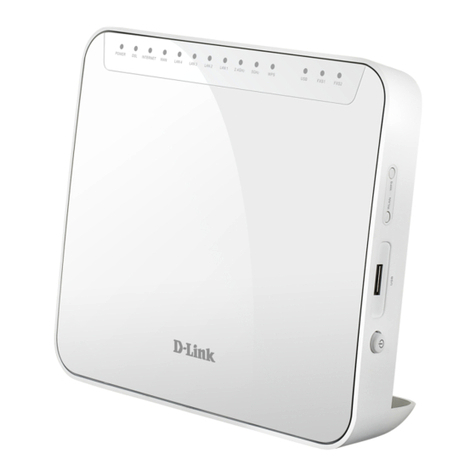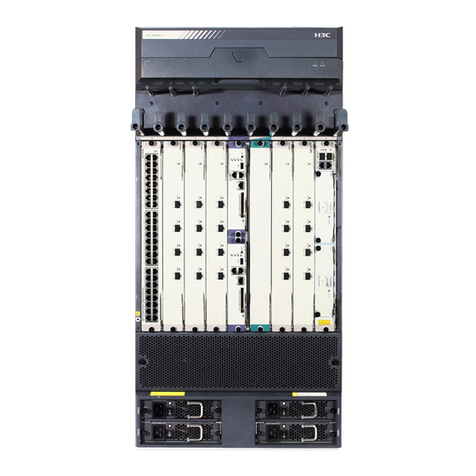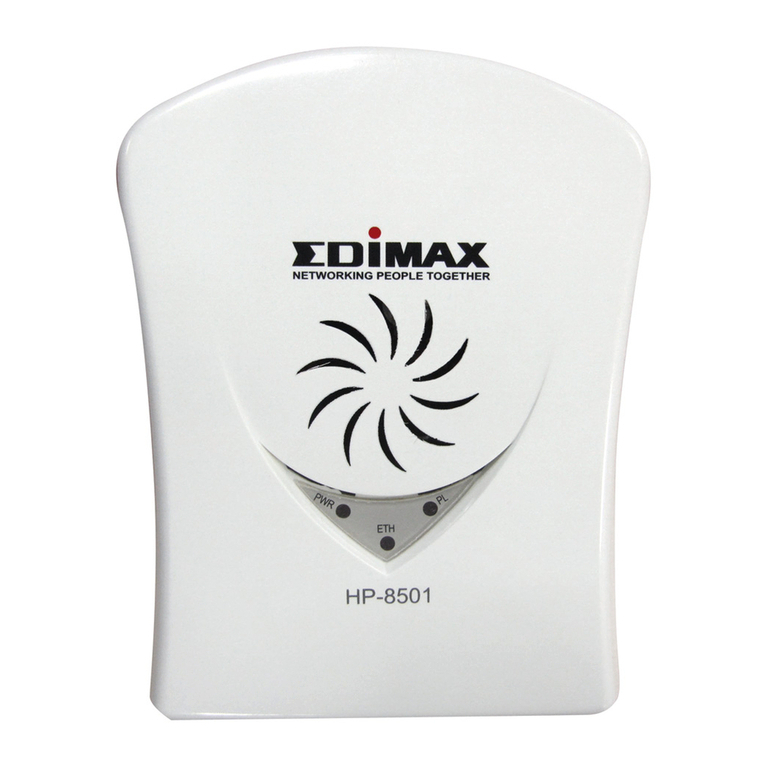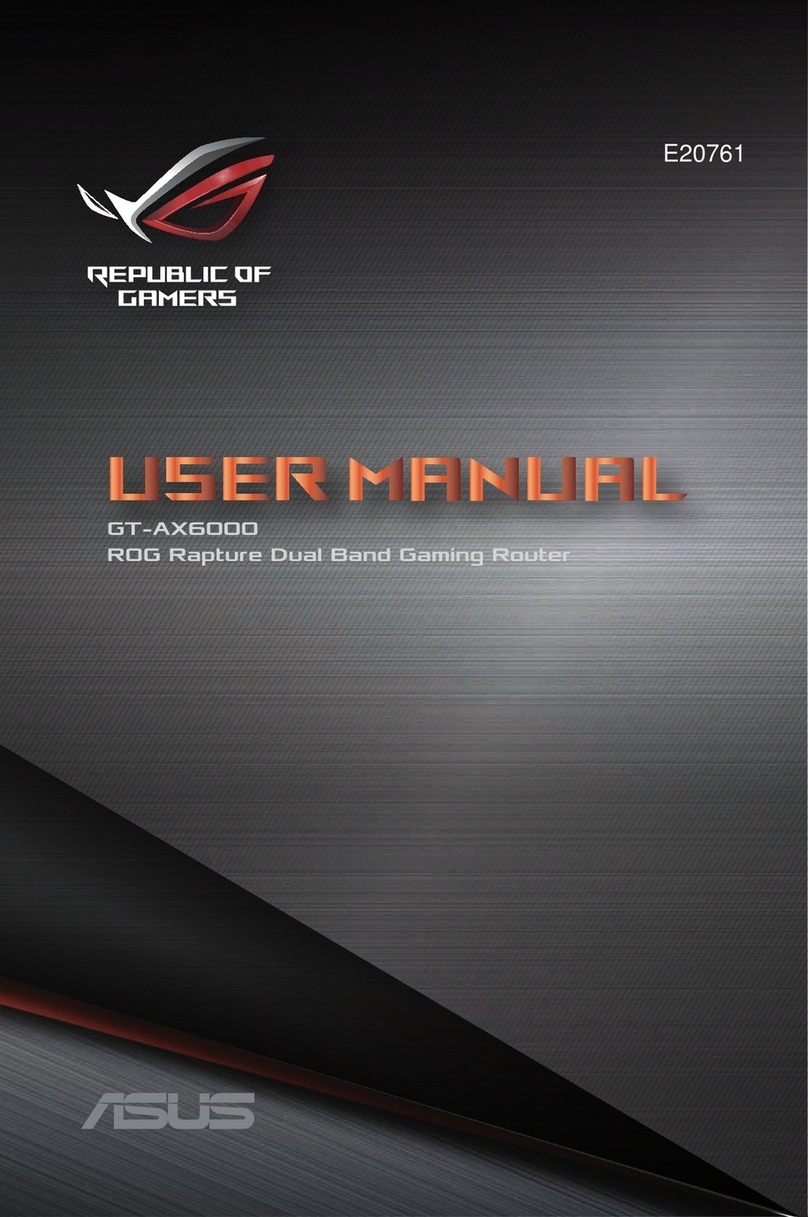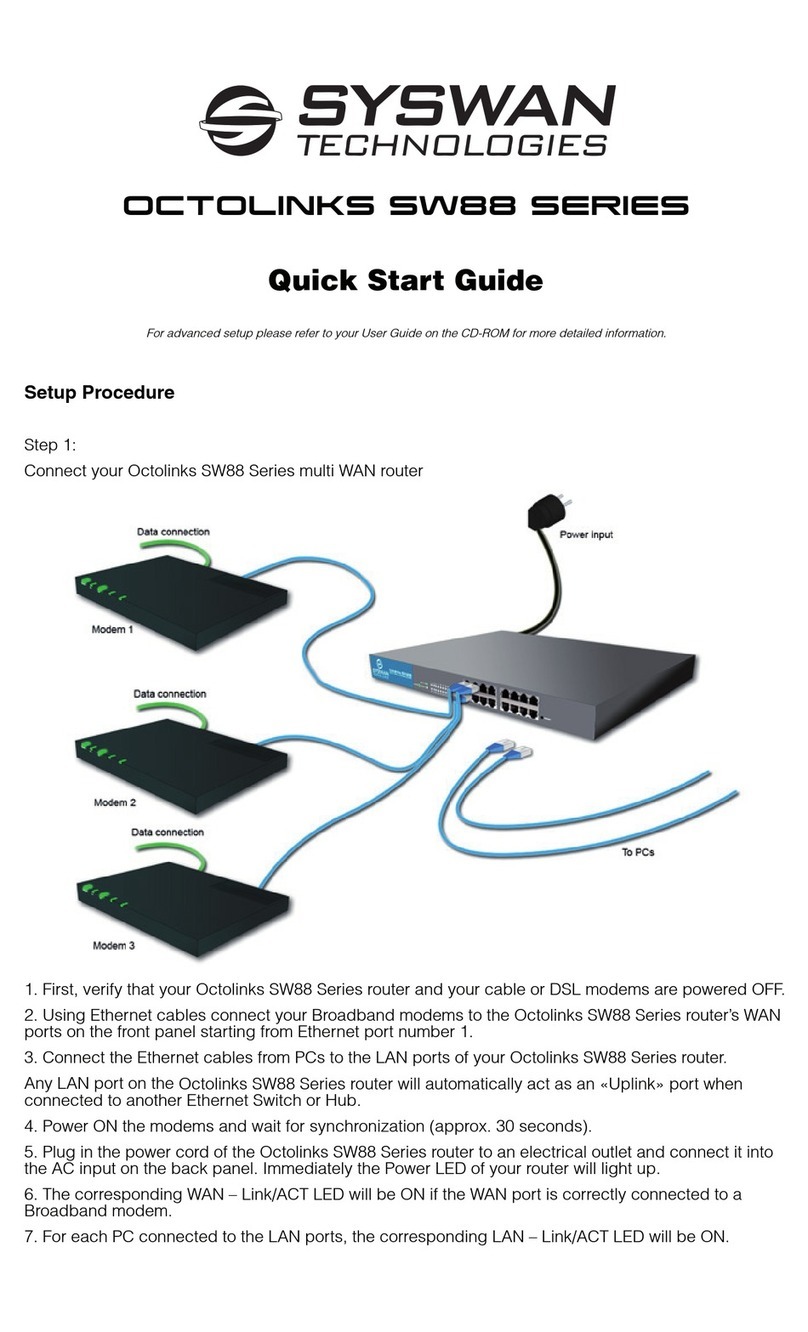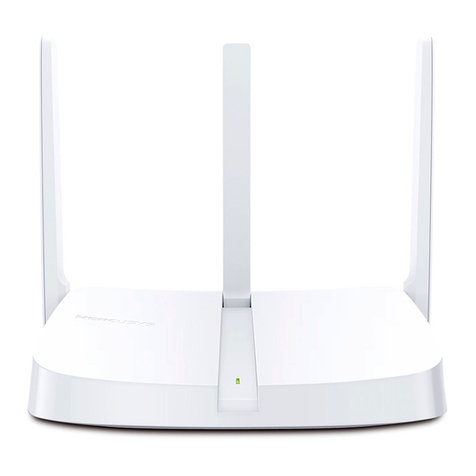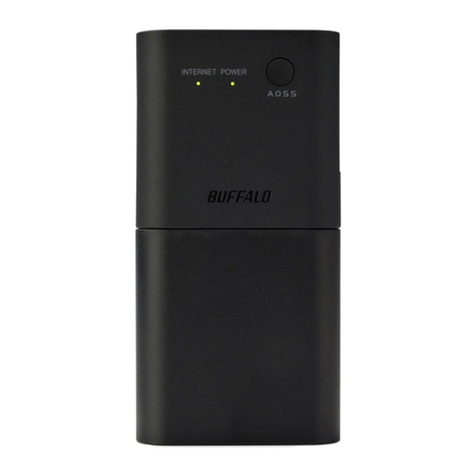Tropos Networks 7320 User manual

Tropos 7320 Router Installation Guide ii
Copyright Notice
©2003-2008 Tropos Networks, Inc. All rights reserved. Tropos and PWRP are registered trademarks of Tropos
Networks, Inc. Tropos Networks, AMCE, TMCX, SABRE, CMDP, MESM and Metro-Scale Mesh Networking
Defined are trademarks of Tropos Networks, Inc. Loctite is a registered trademark of Loctite Corporation, USA. All
other brand or product names are trademarks or registered trademarks of their respective holder(s).
Information contained herein is subject to change without notice. The only warranties for Tropos products and
services are set forth in the express warranty statements accompanying such products and services. Nothing herein
should be construed as constituting an additional warranty. Tropos shall not be liable for technical or editorial errors or
omissions contained herein.
This product includes technology protected by U.S. Patents 6,704,301; 6,965,575; 7,016,328; 7,031,293; 7,058,021;
7,362,737; 7,376,087; 7,397,789; and 7,382,778.
FCC Notice to Users and Operators
This device complies with Part 15 of the FCC Rules. Operation is subject to the following two conditions: (1) this
device may not cause harmful interference, and (2) this device must accept any interference received, including
interference that may cause undesired operation.
This equipment has been tested and found to comply with the limits for a Class B digital device, pursuant to Part 15 of
the FCC Rules. These limits are designed to provide reasonable protection against harmful interference when the
equipment is operated in a commercial environment. This equipment generates, uses, and can radiate radio frequency
energy and, if not installed and used in accordance with the instruction manual, may cause harmful interference to
radio communications. Operation of this equipment in a residential area is likely to cause harmful interference, in
which case the user will be required to correct the interference at his own expense. If this equipment does cause
interference to radio or television reception, which can be determined by turning the equipment off and on, the user is
encouraged to correct the interference by using one of the following measures:
Reorient or relocate the receiving antenna.
Increase separation between the equipment and receiver.
Connect the equipment to an outlet on a circuit different from that to which the receiver is connected.
Consult the dealer or an experienced radio/TV technician.
This Part 15 radio device operates on a non-interference basis with other devices operating at this frequency. Any
changes or modification to said product not expressly approved by Tropos Networks could void the user's authority to
operate this device.
5.8 GHz Point-to-Point and Point-to-Multipoint Systems
Operation of this device in point-to-multipoint systems is limited by federal regulation to
36 dBm EIRP. Unit conducted power in the 5.8 GHz band should be adjusted such that the sum of conducted power
and antenna gain does not exceed 36 dBm EIRP.
The maximum antenna gain for point-to-point operation is 19 dBi. The effective EIRP limit for point-to-point system
is 45 dBm EIRP.
Industry Canada
Notice to users and operators:
This Class B digital apparatus meets all requirements of the Canadian Interference Causing Equipment Regulations.
Operation is subject to the following two conditions: (1) this device may not cause harmful interference, and (2) this
device must accept any interference received, including interference that may cause undesired operation.

Tropos 7320 Router Installation Guide iii
Cet appareillage numérique de la classe B répond à toutes les exigences de l’interférence canadienne causant des
réglements d’équipement. L’opération est sujette aux deux conditions suivantes : (1) cet dispositif peut ne pas causer
l'interférence nocive, et (2) ce dispositif doit accepter n’importe quelle interférence reçue, y compris l'interférence qui
peut causer l’opération peu désirée.
This device has been designed to operate with the antennas listed in Chapter 4, “Antenna Information.”
Antennas not included in the chapter or having a gain greater than 12 dBi in the 2.4 GHz band and 19 dBi
in the 5.8 GHz band are strictly prohibited for use with this device. The required antenna impedance is 50
ohms.
Operation is subject to the following two conditions:
1. This device may not cause interference, and
2. This device must accept any interference, including interference that may cause undesired operation of the
device.
To reduce potential radio interference to other users, the antenna type and its gain should be so chosen that
the equivalent isotropically radiated power (EIRP) is not more than that permitted for successful
communication.
European Union WEEE Notice
It is important for users of this equipment to participate in reuse, recycling, and other forms of recovery. The potential
effects on the environment and human health as a result of the presence of hazardous substances in electrical and
electronic equipment are a waste of natural resources and cause pollution.
For EU member countries, this symbol means: Do not dispose of this equipment as unsorted
municipal waste. This equipment must be collected separately.
The return and collection of this product has not been defined at this time, please contact Tropos
Networks for return and/or collection.

Tropos 7320 Router Installation Guide iv
European Community Language Versions of Informal Statement for Inclusion
in User Information
The following statements are in accordance with Article 6.3 of Directive 1999/5/EC.

Tropos 7320 Router Installation Guide v
STOP!! STOP!! STOP!! STOP!!
READ THIS FIRST!
Important Safety Instructions
The exclamation point within an equilateral triangle is intended to alert the user
to the presence of important operating and maintenance (servicing) instructions
in the literature accompanying the product.
The lightning flash with an arrowhead symbol within an equilateral triangle is intended
to alert the user to the presence of uninsulated “dangerous voltage” within the product’s
enclosure that may be of sufficient magnitude to constitute a risk of electric shock to
persons.
Caution
Read these instructions.
Keep these instructions.
Heed all warnings.
Follow all instructions.
Do not defeat the safety purpose of the grounding.
Only use attachments/accessories specified by the manufacturer.
Refer all servicing to qualified service personnel. Servicing is required when the
apparatus has been damage in any way, such as power-supply cord or plug is damaged,
liquid has been spilled on objects have fallen into the apparatus, the apparatus has been
exposed to rain or moisture, does not operate normally, or has been dropped.
Warning
Risk of personal injury or death when installing this device!
There is a risk of personal injury or death if the router antennas come near electric power
lines. Carefully read and follow all instructions in this manual. By nature of the

Tropos 7320 Router Installation Guide vi
installation, you may be exposed to hazardous environments and high voltage. Use caution when
installing the outdoor system.
This apparatus must be connected to earth ground.
Do not open the unit — risk of electric shock inside.
Risque d'électrocution. Ne pas ouvrir l'unité.
Caution
You are cautioned that any change or modification not expressly approved in this
manual could void your authority to operate this equipment.
Les changements et modifications, non expressément approuvés dans le présent manuel,
peuvent entraîner une interdiction d'utiliser cet appareil pour l'utilisateur.
Service
There are no user-serviceable parts inside. All service must be performed by qualified
personnel.
Vous ne devez pas réparer les pièces se trouvant à l'intérieur de l'appareil. Les réparations
doivent être effectuées uniquement par du personnel qualifié.
The Tropos 7320 router may contain a lithium-ion battery. To avoid the possibility of an
explosion, the router should NOT be exposed to any temperatures higher than
85 degrees C.
The RJ45 connectors of the Tropos 7320 router may source DC power on pins 4,5 and
7,8. The IEEE 802.3 standards allow for pins 4,5 and 7,8 to be used for Power Over
Ethernet. Some products may be incompatible with the Tropos Power Over Ethernet
capability. If such problems occur, make sure that the unit is configured with the Power
Over Ethernet capability set to Off (default setting). If problems persist, use Ethernet
cables that have no connections to the unused pins 4,5 and 7,8.
The Tropos 7320 router is installed in wet, outdoor locations. Make sure closure caps are
installed and all cable connections are securely fastened and waterproofed.

Tropos 7320 Router Installation Guide i
Contents
1 Installing the Router 1
Product Summary. . . . . . . . . . . . . . . . . . . . . . . . . . . . . . . . . . . . . . . . 2
Tropos 7320 Router — FCC . . . . . . . . . . . . . . . . . . . . . . . . . . . . . . 2
Tropos 7320 Router — ETSI. . . . . . . . . . . . . . . . . . . . . . . . . . . . . . 2
Tropos 7320 DC Router. . . . . . . . . . . . . . . . . . . . . . . . . . . . . . . . . . 3
Preparing for Installation. . . . . . . . . . . . . . . . . . . . . . . . . . . . . . . . . . . 3
Model Numbers . . . . . . . . . . . . . . . . . . . . . . . . . . . . . . . . . . . . . . . . 3
Installation Hardware and Tools . . . . . . . . . . . . . . . . . . . . . . . . . . . 5
Site Planning . . . . . . . . . . . . . . . . . . . . . . . . . . . . . . . . . . . . . . . . . . 5
Location Guidelines. . . . . . . . . . . . . . . . . . . . . . . . . . . . . . . . . . . . . 6
Antenna Options . . . . . . . . . . . . . . . . . . . . . . . . . . . . . . . . . . . . . . . 6
Site Surveys. . . . . . . . . . . . . . . . . . . . . . . . . . . . . . . . . . . . . . . . . . . 6
Power Source . . . . . . . . . . . . . . . . . . . . . . . . . . . . . . . . . . . . . . . . . 7
Safety. . . . . . . . . . . . . . . . . . . . . . . . . . . . . . . . . . . . . . . . . . . . . . . . 7
Mounting Strategies . . . . . . . . . . . . . . . . . . . . . . . . . . . . . . . . . . . . . . 8
Proper Use of Hose Clamps. . . . . . . . . . . . . . . . . . . . . . . . . . . . . . . . 9
Pole, Tower, and Streetlight Mounting Instructions . . . . . . . . . . . . . 10
Metal Pole Mounting . . . . . . . . . . . . . . . . . . . . . . . . . . . . . . . . . . . 11
Wood Pole Mounting . . . . . . . . . . . . . . . . . . . . . . . . . . . . . . . . . . . 13
Wood Brace Mounting. . . . . . . . . . . . . . . . . . . . . . . . . . . . . . . . . . 14
Tower Mounting. . . . . . . . . . . . . . . . . . . . . . . . . . . . . . . . . . . . . . . 15
Streetlight Mounting. . . . . . . . . . . . . . . . . . . . . . . . . . . . . . . . . . . . 17
Connecting Cable Attached Antennas . . . . . . . . . . . . . . . . . . . . . . . 18
Waterproofing Antenna Connections. . . . . . . . . . . . . . . . . . . . . . . 20
Installing Attached Antennas. . . . . . . . . . . . . . . . . . . . . . . . . . . . . 21
Grounding the Tropos Router. . . . . . . . . . . . . . . . . . . . . . . . . . . . . . 21
Grounding the Data Protection Device . . . . . . . . . . . . . . . . . . . . . 22
Connecting AC Power . . . . . . . . . . . . . . . . . . . . . . . . . . . . . . . . . . . 23
Categories of Power . . . . . . . . . . . . . . . . . . . . . . . . . . . . . . . . . . . 23
Connecting to AC Power (Category C) . . . . . . . . . . . . . . . . . . . . . 26
Connecting to Streetlight Power (Category C). . . . . . . . . . . . . . . . 27

Tropos 7320 Router Installation Guide ii
Connecting DC Power. . . . . . . . . . . . . . . . . . . . . . . . . . . . . . . . . . 29
Connecting a Data Port . . . . . . . . . . . . . . . . . . . . . . . . . . . . . . . . . . 32
Resetting the Router. . . . . . . . . . . . . . . . . . . . . . . . . . . . . . . . . . . . . 36
Connecting Peripherals . . . . . . . . . . . . . . . . . . . . . . . . . . . . . . . . . . 37
Battery Backup Operation. . . . . . . . . . . . . . . . . . . . . . . . . . . . . . . . . 39
Safety Information. . . . . . . . . . . . . . . . . . . . . . . . . . . . . . . . . . . . . . . 40
Safety Guidelines. . . . . . . . . . . . . . . . . . . . . . . . . . . . . . . . . . . . . . 41
Service Instructions . . . . . . . . . . . . . . . . . . . . . . . . . . . . . . . . . . . . 41
2 Power Consumption 43
3 Product Specifications 46
4 Approved Antenna Configurations and Attenuation Settings 54
High Power Product Antennas . . . . . . . . . . . . . . . . . . . . . . . . . . . . . 54
U.S. and Canada. . . . . . . . . . . . . . . . . . . . . . . . . . . . . . . . . . . . . . 54
Standard Power Product Antennas . . . . . . . . . . . . . . . . . . . . . . . . . 56
Europe. . . . . . . . . . . . . . . . . . . . . . . . . . . . . . . . . . . . . . . . . . . . . . 56
5 Antenna Specifications and Patterns 58
6 Installation Accessories 68
7 AC Wiring Diagrams 71
8 Wind Loading Considerations 74
9 Canopy Installation Instructions 75
10 Cable Termination Instructions 78
11 Strand Mount Kit Installation Instructions 81
Kit Contents. . . . . . . . . . . . . . . . . . . . . . . . . . . . . . . . . . . . . . . . . . 81
Abbreviations . . . . . . . . . . . . . . . . . . . . . . . . . . . . . . . . . . . . . . . . . . . . . . . . 84
Index . . . . . . . . . . . . . . . . . . . . . . . . . . . . . . . . . . . . . . . . . . . . . . . . . . . . . . . 87

Chapter 1
Tropos 7320 Router Installation Guide iii
List of Figures
Tropos 7320 Router Exploded View . . . . . . . . . . . . . . . . . . . . . . . . . . . . . . . . . . 4
Example Mounting Location - Antennas Facing Upward . . . . . . . . . . . . . . . . . . 8
Proper Use of Hose Clamps . . . . . . . . . . . . . . . . . . . . . . . . . . . . . . . . . . . . . . . . 9
Metal Pole Mounting . . . . . . . . . . . . . . . . . . . . . . . . . . . . . . . . . . . . . . . . . . . . . 11
Sun Shield Connections . . . . . . . . . . . . . . . . . . . . . . . . . . . . . . . . . . . . . . . . . . 12
Wood Pole Mounting . . . . . . . . . . . . . . . . . . . . . . . . . . . . . . . . . . . . . . . . . . . . . 13
Wood Brace Mounting Option . . . . . . . . . . . . . . . . . . . . . . . . . . . . . . . . . . . . . . 14
Tower Mounting . . . . . . . . . . . . . . . . . . . . . . . . . . . . . . . . . . . . . . . . . . . . . . . . . 15
Streetlight Mounting . . . . . . . . . . . . . . . . . . . . . . . . . . . . . . . . . . . . . . . . . . . . . 17
Connecting External Antennas . . . . . . . . . . . . . . . . . . . . . . . . . . . . . . . . . . . . . 19
Waterproofing Antenna Connections . . . . . . . . . . . . . . . . . . . . . . . . . . . . . . . . 20
Grounding Arrangement . . . . . . . . . . . . . . . . . . . . . . . . . . . . . . . . . . . . . . . . . . 21
Grounding the Indoor Network Protection Unit . . . . . . . . . . . . . . . . . . . . . . . . . 22
IEEE/ANSI C62.41 Power Categories . . . . . . . . . . . . . . . . . . . . . . . . . . . . . . . . 25
Connecting Category C AC Power . . . . . . . . . . . . . . . . . . . . . . . . . . . . . . . . . . 26
Connecting the AC Power Cable . . . . . . . . . . . . . . . . . . . . . . . . . . . . . . . . . . . . 27
Connecting Streetlight Power . . . . . . . . . . . . . . . . . . . . . . . . . . . . . . . . . . . . . . 28
Tropos 7320 DC Router Connections . . . . . . . . . . . . . . . . . . . . . . . . . . . . . . . . 30
DC Terminal Block Location . . . . . . . . . . . . . . . . . . . . . . . . . . . . . . . . . . . . . . . 31
Using the Terminal Block Levers . . . . . . . . . . . . . . . . . . . . . . . . . . . . . . . . . . . . 32
Options for Connecting a Data Port . . . . . . . . . . . . . . . . . . . . . . . . . . . . . . . . . 33
Data Port Connection . . . . . . . . . . . . . . . . . . . . . . . . . . . . . . . . . . . . . . . . . . . . 35
Circuit Board Connection Locations . . . . . . . . . . . . . . . . . . . . . . . . . . . . . . . . . 36
RJ45 Pin Locations . . . . . . . . . . . . . . . . . . . . . . . . . . . . . . . . . . . . . . . . . . . . . . 38
Average Battery Backup Time . . . . . . . . . . . . . . . . . . . . . . . . . . . . . . . . . . . . . . 39
7320 AC Power Consumption: 25°C, No Battery Backup . . . . . . . . . . . . . . . . . 43
7320 AC Power Consumption: -40°C, Battery Backup . . . . . . . . . . . . . . . . . . . 44
AC Wiring — Photoelectric Power Tap . . . . . . . . . . . . . . . . . . . . . . . . . . . . . . . 72
AC Wiring Power Cable 120VAC, 15A Plug . . . . . . . . . . . . . . . . . . . . . . . . . . . 73
Canopy Assembly . . . . . . . . . . . . . . . . . . . . . . . . . . . . . . . . . . . . . . . . . . . . . . . 76
Cable Components . . . . . . . . . . . . . . . . . . . . . . . . . . . . . . . . . . . . . . . . . . . . . . 78
Cable Gland Assembly . . . . . . . . . . . . . . . . . . . . . . . . . . . . . . . . . . . . . . . . . . . 79
Cable Preparation and Termination . . . . . . . . . . . . . . . . . . . . . . . . . . . . . . . . . 79

Chapter 1
Tropos 7320 Router Installation Guide iv
Strand Mount Kit Items . . . . . . . . . . . . . . . . . . . . . . . . . . . . . . . . . . . . . . . . . . . 81
Attaching Strand Mount Brackets . . . . . . . . . . . . . . . . . . . . . . . . . . . . . . . . . . . 82
Preparing the Bracket . . . . . . . . . . . . . . . . . . . . . . . . . . . . . . . . . . . . . . . . . . . . 82
Tightening the Clamps . . . . . . . . . . . . . . . . . . . . . . . . . . . . . . . . . . . . . . . . . . . 83

Chapter 1
Tropos 7320 Router Installation Guide v
List of Tables
Tropos 7320 Router Models—FCC . . . . . . . . . . . . . . . . . . . . . . . . . . . . . . . . . . . 2
Tropos 7320 Standard Router Models—ETSI . . . . . . . . . . . . . . . . . . . . . . . . . . . 2
Tropos 7320 DC Router Models . . . . . . . . . . . . . . . . . . . . . . . . . . . . . . . . . . . . . 3
IEEE/ANSI C62.41 Power Categories . . . . . . . . . . . . . . . . . . . . . . . . . . . . . . . . 23
PoE Power Sourcing Power Output . . . . . . . . . . . . . . . . . . . . . . . . . . . . . . . . . 37
RJ45 Pin Descriptions for Data Connection . . . . . . . . . . . . . . . . . . . . . . . . . . . 38
Physical Specifications - Tropos 7320 Router . . . . . . . . . . . . . . . . . . . . . . . . . . 46
Interfaces . . . . . . . . . . . . . . . . . . . . . . . . . . . . . . . . . . . . . . . . . . . . . . . . . . . . . . 48
Power Options / Consumption . . . . . . . . . . . . . . . . . . . . . . . . . . . . . . . . . . . . . . 51
Power Over Ethernet - Power Sourcing . . . . . . . . . . . . . . . . . . . . . . . . . . . . . . 52
Certifications, Other . . . . . . . . . . . . . . . . . . . . . . . . . . . . . . . . . . . . . . . . . . . . . . 52
Power Options / Consumption - Tropos 7320 DC Router . . . . . . . . . . . . . . . . . 53
Certifications - Tropos 7320 DC Router . . . . . . . . . . . . . . . . . . . . . . . . . . . . . . 53
802.11b/g/n Antenna Configurations (2400-2483 MHz) . . . . . . . . . . . . . . . . . . 55
802.11a/n Radio (5725-5850 MHz) - Antenna Configurations . . . . . . . . . . . . . 55
802.11b/g/n Antenna Configurations (2400-2500 MHz) . . . . . . . . . . . . . . . . . . 56
802.11a/n Radio (5470-5725 MHz) - Antenna Configurations . . . . . . . . . . . . . 57
Antenna Specifications and Patterns . . . . . . . . . . . . . . . . . . . . . . . . . . . . . . . . 59
Installation Accessories . . . . . . . . . . . . . . . . . . . . . . . . . . . . . . . . . . . . . . . . . . . 68
Tropos Antennas, Cables, and Related Ordering Numbers . . . . . . . . . . . . . . . 69
Canopy Cable Wiring . . . . . . . . . . . . . . . . . . . . . . . . . . . . . . . . . . . . . . . . . . . . 77
TIA/EIA 5688 Wiring - RJ-45 Pin Descriptions for Data Connection . . . . . . . . . 79

Tropos 7320 Router Installation Guide 1
1Installing the Router
This guide explains how to install the Tropos®7320 Mesh router safely and is intended for
trained technical professionals. This chapter covers the following topics:
“Product Summary” on page 2
“Preparing for Installation” on page 3
“Mounting Strategies” on page 8
“Proper Use of Hose Clamps” on page 9
“Pole, Tower, and Streetlight Mounting Instructions” on page 10
“Connecting Cable Attached Antennas” on page 18
“Grounding the Tropos Router” on page 21
“Connecting AC Power” on page 23
“Connecting a Data Port” on page 32
“Resetting the Router” on page 36
“Connecting Peripherals” on page 37
“Battery Backup Operation” on page 39
“Safety Information” on page 40

Chapter 1
Tropos 7320 Router Installation Guide 2
Product Summary
This document contains installation instructions for the following products:
Tropos 7320 Router — FCC
Tropos 7320 Router — ETSI
Tropos 7320 DC Router
Preparing for Installation
Tropos 7320 Router — FCC
The Tropos 7320 router for the FCC regulatory domain has the following characteristics:
802.11a/b/g/n dual band, 2400-2483 MHz/5470-5850 MHz
Support for 802.11a/b/g/n clients
AC power, 100-480 VAC, 50/60 Hz
Battery back-up option
LAN and Management 10/100BaseT Ethernet ports
Programmable PoE output sourcing at 30W
Table 1 lists the Tropos 7320 router models for the FCC regulatory domain.
Tropos 7320 Router — ETSI
The Tropos 7320 router for the ETSI regulatory domain has the following characteristics:
802.11a/b/g/n dual band, 2400-2500 MHz/5470-5725 MHz
Support for 802.11a/b/g/n clients
AC power, 100-480 VAC, 50/60 Hz
Battery back-up option
LAN and Management 10/100BaseT Ethernet ports
Programmable PoE output sourcing at 30W
Table 2 lists the Tropos 7320 router models for the ETSI regulatory domain.
TABLE 1 Tropos 7320 Router Models—FCC
Model Description
73203030 7320: 2.4 and 5.8 GHz, AC power, NoBatt
73203130 7320: 2.4 and 5.8 GHz, AC power, Batt
TABLE 2 Tropos 7320 Standard Router Models—ETSI
Model Description
73202531 7320: 2.4 and 5.4 GHz, AC power, NoBatt

Chapter 1
Tropos 7320 Router Installation Guide 3
Tropos 7320 DC Router
The Tropos 7320 DC router has the following characteristics:
802.11a/b/g/n dual band, 2400-2500 MHz/5470-5725 MHz or 2400-2483 MHz/5725-5850
MHz
Support for 802.11a/b/g/n clients
DC power only, 12-60Vdc
No battery backup
LAN and Management 10/100BaseT Ethernet ports
No programmable PoE output sourcing capabilities
Table 3 lists the Tropos 7320 DC router models.
Preparing for Installation
The Tropos 7320 router must be installed by a trained professional, value added reseller, or
systems integrator who is familiar with RF planning issues and regulatory limits defined by the
governing body of the country in which the unit will be installed. This section explains how to
prepare the installation site.
Model Numbers
An exploded view of the Tropos 7320 router assembly is shown in Figure 1.
Note
Antenna(s) must be installed by a trained professional. Operating the unit with non-qualified antennas is a
violationof U.S.FCC RulesPart15.203(c),Code ofFederalRegulations,Title47. See“Approved Antenna
Configurations and Attenuation Settings” on page 54 for a listing of antenna options.
73202631 7320: 2.4 and 5.4 GHz, AC power, Batt
TABLE 2 Tropos 7320 Standard Router Models—ETSI (continued)
Model Description
TABLE 3 Tropos 7320 DC Router Models
Model Description
73206000 7320: 2.4 & 5.8 GHz, DC Power, NoBatt, FCC
73206060 7320: 2.4 & 5.4 GHz, DC Power, NoBatt, ETSI

Chapter 1
Tropos 7320 Router Installation Guide 4
FIGURE 1 Tropos 7320 Router Exploded View
trp_196
10/100 BaseT
LAN cable
#10-32
hex head 5/16"
machine screws
x 5
Pole bracket
10/100 BaseT
Management cable
Shielded outdoor
cat5 cable
Cable gland
802.11b/g/n
Tx/Rx antenna
802.11a/n
Tx/Rx
antenna
Router
Sun shield Hose
clamps
Ground
bolt
Bottom view of Router
Connector
access cover
Connector
access cover
without
cable glands
AC input
power connector
LED
Quick tie
anchors
802.11b/g/n
Rx antennas

Chapter 1
Tropos 7320 Router Installation Guide 5
Installation Hardware and Tools
Tropos Networks provides the following accessories to install the Tropos 7320 router:
One pole bracket
One sun shield
Two 4-inch diameter hose clamps
Four 6-inch diameter hose clamps
Five 5/16-inch #10-32 stainless steel hex head machine screws
You must supply the following tools:
5/16-inch nut driver
1/4-inch flat blade screwdriver
Tower mounting only: supply stainless or galvanized steel channel stock and 1/2-inch or
5/8-inch nuts, bolts, and washers to connect to the tower arm.
Wood pole mounting only: two 1/4-inch diameter, 3 1/2-inch long lag bolts
Site Planning
To ensure safe and durable wiring, installation of the Tropos 7320 router must follow
appropriate electrical and building codes. Follow the National Electrical Code (NEC)
requirements, unless local codes in your area take precedence over the NEC code.
The following distance limits apply to installations that have 10/100 Base-T Category 5 network
cables attached to the Tropos 7320 router:
300 feet maximum between devices for 100BaseT operation
500 feet maximum for 10BaseT operation.
The Ethernet duplex and speed setting is configurable.
Note
National Electrical Codes (NEC) Article 800 requires the use of Agency Listed (UL/CSA/TUV) Building
Entrance Protector for all power and data communications cables entering a building. The NEC intends by
Article800to protectthebuildingandoccupantsfrom firescausedby transient voltage andcurrentsurges.
Note
Ethernet data cableinstallations having lengths greater than 140 feet in theoutdoor environment must use
a UL497 approved (UL/CSA/TUV Listed) primary protection device at the building entrance. Ethernet data
cable installations having lengths less than 140 feet in the outdoor environment may use a UL497A (UL/
CSA/TUVListed)secondaryprotectiondeviceat thebuilding entrance. Tropos DataProtectionDevice and
Network Protection Units are UL497A secondary protection devices.

Chapter 1
Tropos 7320 Router Installation Guide 6
Location Guidelines
The Tropos 7320 router is a radio devices and therefore susceptible to interference that can
reduce throughput and range. Follow these guidelines to ensure the best performance:
Install the unit in an area where trees, buildings, and large steel structures do not obstruct
radio signals to and from the antenna. Direct line-of-sight operation is best.
Install the unit away from microwave ovens or other devices operating in the 2.4 GHz,
4.9 GHZ, or 5.8 GHz frequency range.
Install the unit away from other possible sources of 802.11a/b/g/n interference, such as
cordless phones, home spy cameras, frequency hopping (FHSS) and DSSS LAN
transceivers (non-802.11), electronic news gathering video links, radars, amateur radios,
land mobile radio services, local government sites (such as law enforcement), fixed
microwave services, local TV transmission and private fixed point transmitters.
Antenna Options
You can purchase the Tropos 7320 router with an omni-directional antenna, or use an approved
external antenna. Omni-directional antennas are best for systems requiring a signal distribution
in more than one direction. For antenna model numbers, refer to “Approved Antenna
Configurations and Attenuation Settings” on page 54.
Note
Antenna(s) must be installed by a trained professional. Operating the unit with non-qualified antennas is a
violationof U.S.FCC RulesPart15.203(c),Code ofFederalRegulations,Title47. See“Approved Antenna
Configurations and Attenuation Settings” on page 54 for a listing of antenna options.
Site Surveys
Due to variations in component configuration, placement, and physical environment, each
installation is unique. Before installing the Tropos 7320 router, perform a site survey to
determine the optimum placement of units for maximum range, coverage, and network
performance. Consider the following factors when performing a site survey:
Data rates—Sensitivity and range are inversely proportional to data bit rates. The maximum
radio range is achieved at the lowest workable data rate. A decrease in receiver threshold
sensitivity occurs as radio data rate increases.
Antenna type and placement—Proper antenna configuration is a critical factor in
maximizing radio range. As a general rule, range increases in proportion to gain and antenna
height measured from the ground.
Physical environment—Clear or open areas provide better radio range than closed or filled
areas. The less cluttered the operating environment, the greater the range.
Obstructions—A physical obstruction, such as a building or tree, can block or hinder
communication. Avoid locating antennas in a location where there is an obstruction between
sending and receiving devices.

Chapter 1
Tropos 7320 Router Installation Guide 7
Building materials—Radio penetration is influenced by the building material used in
construction. For example, drywall construction permits greater range than concrete blocks.
Power Source
The Tropos 7320 router supports the following options for connecting to a power source:
AC Power
AC power source (3-wire service) — 3W(P+N+PE) or 3W(2P+PE); 100-480 VAC, 50/60
Hz
NEMA plug, for streetlight photoelectric control power tap (2-wire service) —2W(2P) or
2W(P+N); 100-480 VAC 50/60 Hz
In Europe, a suitably-rated plug provided by the installer
DC Power
For the Tropos 7320 DC router—12-60Vdc, 3.5A - 0.7A
Warning
Connect the AC or DC poweredoutdoor systemonly toasuitably-rated powersource. Donotconnect
to a power source of other voltage.
Caution
You must install an external grounding wire if the router is installed on a non-metal pole or if the
metal installation structure is not properly grounded. You must also ground the outdoor data
protection device to a bonded pipe or ground rod. Make sure that grounding is complete before
you connect power to the router.
Safety
Installing the Tropos 7320 router can pose a serious hazard. Be sure to take precautions to avoid
the following:
Exposure to high voltage lines during installation
Falls when working at heights or with ladders
Injuries from dropping tools and equipment
Contact with AC wiring

Chapter 1
Tropos 7320 Router Installation Guide 8
Mounting Strategies
When choosing mounting locations, consider the available mounting structures and antenna
clearance. The router should always be mounted with the top of the unit horizontal and level and
with the antennas facing upward.
It is usually best to attach ground and data cables to the router prior to mounting. Before
mounting the router, review the wiring instructions in “Grounding the Tropos Router” on page
21 and “Connecting a Data Port” on page 32 to determine the best strategy for the selected
location.
Note
To eliminate potential interference from the mounting structure, the router should be mounted with at least
4 feet of clearance around the antennas.
Acceptable options for mounting on a streetlight are shown in Figure 2. In each case the router is
mounted to assure clearance for the antennas above the height of the streetlight.
FIGURE 2 Example Mounting Location - Antennas Facing Upward
trp_197
Antennas clear of obstruction
Antennas clear
of obstruction
Table of contents
Other Tropos Networks Network Router manuals


